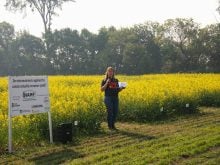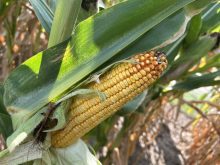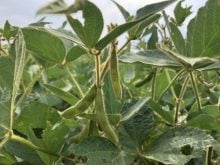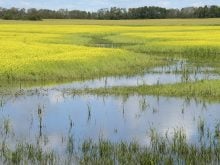Another milestone in the development of juncea canola takes place this year when Viterra conducts field trials on its first generation of Xceed hybrids.
Juncea canola is one of the world’s first drought tolerant crops and is well suited to the Prairies’ brown soil zones.
However, the crop has experienced a yield drag compared to napus canola.
Viterra hopes to address that shortcoming with its new hybrid lines, which could be commercially available by 2013 if they perform as expected.
Read Also

GSI’s GrainVue allows for remote grain bin monitoring
GSI’s GrainVue bin monitoring system allows producers to monitor grain conditions inside the bin and automate any drying, cooling or aerating that is needed to keep grain in peak condition.
“We’re anxious to see what type of (yield) boost we see from hybrids over the open pollinated material that we’ve been working with,” said Monte Kesslering, Viterra’s vice-president of seed and crop protection.
The company created the hybrids by combining the best germplasm from its two breeding programs. Material from the Canadian program has its heritage in Europe and Canada, while the Australian program is a mix of Indian and Australian genetics.
“We think we’ll see significant performance benefits from doing that,” said Kesslering.
Viterra will test its Clearfield hybrids at 20 sites in Western Canada, North Dakota and Montana.
Canadian trials will be conducted in the brown soil zones, which the company learned the hard way is the region best suited for the new crop.
Viterra released its first herbicide tolerant lines of Xceed in 2009, contracting 70,000 acres with 250 prairie growers.
Growing conditions demonstration trials in 2008 gave the false impression that juncea canola was well suited to a broad cross-section of the prairie region.
The theory was shot down in 2009 when growers in the black soil zones reported disappointing yields compared to napus varieties.
“It was a bit of a learning experience for everyone, that what we had for products was well adapted to the brown soil zones but not necessarily for regions outside of that,” said Kesslering.
The following year, the company limited its contracting program to 125 growers in the brown soil zone. However, it also wasn’t an ideal test of the crop because of excess moisture.
One of the main benefits of juncea canola is its ability to withstand heat and drought during the flowering period because of its deep root system.
“It doesn’t mean that you’re going to get a phenomenal crop in very dry years, but you’re going to get a reasonable crop,” said Kesslering.
“We’ve seen some just dramatic yield differences when you get those extreme hot, dry type years.”
However, 2010 wasn’t one of those years.
The Xceed varieties delivered average yields of 23 bushels per acre compared to 26 bu. for competing napus varieties, including hybrids.
Farmers were impressed with the ability to straight combine the Xceed varieties, which saved them time and money on swathing.
“That continues to be by far what gets farmers most excited about this crop,” said Kesslering.
However, a publicly funded research project found Xceed’s pod shattering advantages are not all that noticeable.
Chris Holzapfel, who works for the Indian Head Agricultural Research Foundation, tested Xceed against four napus varieties at four Saskatchewan plots in Indian Head, Scott, Melfort and Swift Current.
“When you looked at all of the data, there was no clear advantage,” he said.
Xceed performed as well in some trials as Invigor 5440, the most consistently shatter resistant variety, but on average it was no better than its competition, which was a surprise.
“We were expecting to see more of a benefit,” said Holzapfel.
He said many of the research trials sponsored by the Saskatchewan Canola Development Commission were conducted outside of Viterra’s target area for Xceed. As well, the technology used in the experiment would not be able to pick up subtle differences in pod shattering resistance.
“There is a fair bit of experimental error with shattering trays. The results tend to be fairly noisy,” said Holzapfel.
Pioneer Hi-Bred, the first company to launch a juncea hybrid, also sees value in juncea canola in the southern Prairies. It will continue with its breeding program but not at the same level of commitment as previous years.
“It’s more or less on the back burner. We’re not launching any new products right now,” said Greg Stokke, Pioneer’s western Canadian marketing manager.
“We slowed it down a bit and the reason being is there’s a lack of herbicide options available for the juncea. We don’t have Clearfield or Roundup or Liberty in it.”
Pioneer Hi-Bred is instead focusing on breeding shatter tolerance into lines of napus canola. Stokke said growers can expect the commercial release of some of those lines within the next five years.
The lines wouldn’t have the same deep root system as juncea canola, but they would have high vigour and great establishment, which would help protect the crop against drought.
Kesslering said Viterra’s juncea program is still going strong despite the setbacks.
“It’s a crop that we continue to believe has a lot of promise,” he said.
Viterra expects the new Xceed hybrids will not only deliver a yield boost but also enhance the heat and drought tolerance abilities of juncea canola.
Viterra’s customers also believe in the crop.
Xceed looks different from regular canola because of its yellow seed coat, but the oil and meal profiles are largely similar to napus varieties.
The company has an end-use market that prefers Xceed meal to that from napus varieties, which is why Viterra has a contracting program that pays Xceed growers a $1.25 per bu. premium over traditional canola.















